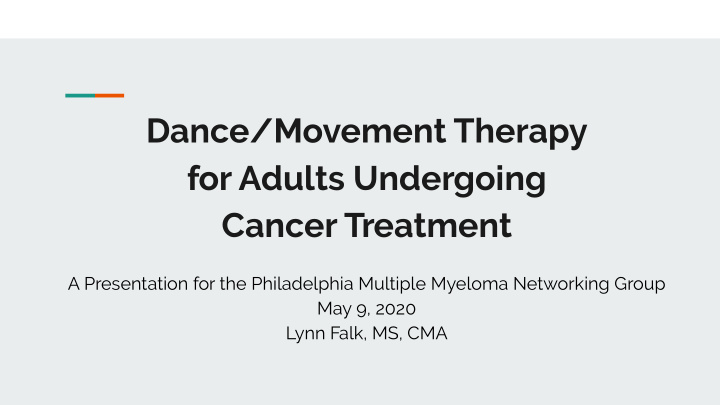



Dance/Movement Therapy for Adults Undergoing Cancer Treatment A Presentation for the Philadelphia Multiple Myeloma Networking Group May 9, 2020 Lynn Falk, MS, CMA
Brief bio: MS in Dance, University of Oregon ● CMA, Laban/Bartenieff Institute of Movement Studies ● MA in DMT & Counseling, expected 2021, Drexel University ● Dance teaching artist 1998 - 2018 ● DMT Clinical experience ● Youth Consultation Service, Sewell, NJ ○ Haven Behavioral Hospital, Philadelphia ○ Penn Medicine, Dept. of Radiation Oncology, Perelman Center ○
What is Dance/Movement Therapy (DMT)? ● DMT is “the psychotherapeutic use of movement to promote emotional, social, cognitive and physical integration of the individual” (ADTA, n.d.). ● Originally practiced in mental health settings, DMT lends itself to medical settings: ○ Oncology, rehabilitation units, palliative care, inpatient pediatric care, etc. ● Adaptable and accessible to all ages, abilities, genders, and cultures. ● Encompasses a range of interventions: ○ breathing exercises, guided imagery, gentle stretching, expressive movement, & use of dance technique or choreographic tools
Main premises of DMT Movement is communication. ● Relationships are therapeutic and ● healing. Reciprocal nature of the mind-body ● connection
Five core foci of medical DMT (Goodill, 2006) Vitality ● ● Mood ( Dibble-Hope, 2000) ● Body image of illness Relationship-focused coping ● Self-efficacy ●
Psychosocial impact of cancer Physical Psychological Health Health Body Mind
Shim, M, Goodill, S., & Bradt, J. (2019). Mechanisms for dance/movement therapy for building resilience in people with chronic pain. American Journal of Dance Therapy , doi.org/10.1007/s1046 5-019-09294-7
Ho et al., (2016) . A good time to dance? A mixed-methods approach of the effects of DMT for breast cancer patients during and after radiotherapy. Cancer Nursing, 39 (1), 32-41. doi:10.1097/NCC.0000000000000237 ● Chinese-speaking breast cancer patients currently undergoing radiotherapy (n= 60) and those who had previously completed radiotherapy (n=44) ● 6 total 90-minute sessions twice a week for 3-weeks (Eastern philosophies & Western DMT structures) ● Qualitative data ● Significant improvement for patients currently in treatment* and those who completed radiation treatment in ○ disease and coping with treatment*, and physical symptoms, ○ mental well-being*, attention, and appreciation for the self and body*, ○ total functioning, ○ bridging back to a normal and better life, and ○ participation in a shared positive experience.
References ADTA. (n.d.). What is dance/movement therapy? FAQs. https:/ /adta.org/faqs/ Dibbell-Hope, S. (2000). The use of dance/movement therapy in psychological adaptation to breast cancer. The Arts in Psychotherapy, 27 (1), 51-68. doi:10.1016/S0197-4556(99)00032-5 Goodill, S. W. (2006). Dance/movement therapy for people living with medical illness. In S. C. Koch & I. Bräuninger (Eds.), Advance in dance/movement therapy: Theoretical perspectives and empirical findings (pp. 52-60). Berlin: Logos Verlag. Ho, R. T. H., Lo, P. H. Y., & Luk, M. Y. (2016;2015). A good time to dance? A mixed-methods approach of the effects of dance movement therapy for breast cancer patients during and after radiotherapy. Cancer Nursing, 39 (1), 32-41. doi:10.1097/NCC.0000000000000237 Kayser, K., Watson, L. E., & Andrade, J. T. (2007). Cancer as a "we-disease": Examining the process of coping from a relational perspective. Families, Systems, & Health, 25 (4), 404-418. doi:10.1037/1091-7527.25.4.404 Shim, M, Goodill, S., & Bradt, J. (2019). Mechanisms for dance/movement therapy for building resilience in people with chronic pain. American Journal of Dance Therapy , doi.org/10.1007/s10465-019-09294-7 Siegel, R., Miller, K., & Jemal, A. (2020, January 8). Cancer statistics, 2020 . ACS Journals. https:/ /acsjournals.onlinelibrary.wiley.com/doi/full/10.3322/caac.21590 Zwahlen, D., Hagenbuch, N., Jenewein, J., Carley, M. I., & Buchi, S. (2011). Adopting a family approach to theory and practice: Measuring distress in cancer patient–partner dyads with the distress thermometer. Psycho ‐ oncology, 20 (4), 394-403. doi:10.1002/pon.1744
Recommend
More recommend